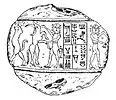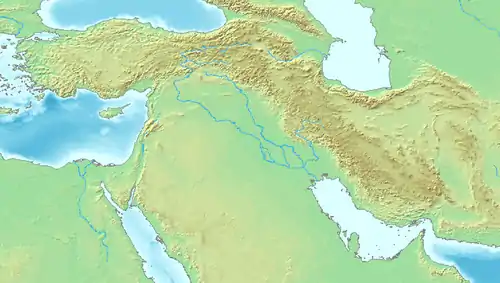Epirmupi
Epirmupi (𒂊𒉆𒈬𒉈 E-pir-mu-pil, previously read E-nam-mu-de) was a ruler of Elam around 2199–2154 BCE. His name is purely Akkadian, and he was in charge of Elam at the time of Rimush and Manishtushu, or early in the reign of Naram-Sin and probably their dependent and vassal.[3][4][5] His title of "Military Governor" (Shakkanakku in Akkadian, GIR.NITA in Sumerian) suggests that he was a dependent of the Akkadian kings, rather than an independent ruler.[6] He also held the title of Ensi of Susa".[7]
| Epirmupi 𒂊𒉆𒈬𒉈 | |
|---|---|
| Military Governor of Elam | |
 | |
| Reign | c. 2199–2154 BCE |
| Predecessor | Eshpum |
| Successor | Ili-ishmani |
| Dynasty | Akkadian Governor of Elam |
His successor was probably Ili-ishmani.[8] After Ili-ishmani, and the weakening of the Akkadian Empire, rule in Elam reverted to local rulers of the Awan Dynasty.[9]
Seal inscriptions
Various inscriptions in the name of Epirmupi are known, especially "Epirmupi, the Shakkanakku of the land of Elam” and "Epirmupi, Ensi of Susa".[7]
A seal is known with the inscription "Epirmupi, the strong, Liburbeli, cup-bearer, your servant", incorporating the image of two heroic combats: a naked hero versus a lion and a naked hero against a buffalo. The seal is now in the Louvre Museum.[10][11]
 Seal of "Liburbeli, servant of the Great Epirmupi". Louvre Museum Sb 6673.[12]
Seal of "Liburbeli, servant of the Great Epirmupi". Louvre Museum Sb 6673.[12] Seal of "Liburbeli, servant of the Great Epirmupi" (detail). Louvre Museum Sb 6673.[13]
Seal of "Liburbeli, servant of the Great Epirmupi" (detail). Louvre Museum Sb 6673.[13] Seal of "Epirmupi Ensi of Susa" (𒂊𒉆𒈬𒉈 𒑐𒋼𒋛 𒋢𒉆𒆠, last three columns)
Seal of "Epirmupi Ensi of Susa" (𒂊𒉆𒈬𒉈 𒑐𒋼𒋛 𒋢𒉆𒆠, last three columns)
 Seal with inscription "Epirmupi Shakkanakku of the Country of Elam" 𒂊𒉆𒈬𒉈 𒄊𒀴 𒉏𒆠
Seal with inscription "Epirmupi Shakkanakku of the Country of Elam" 𒂊𒉆𒈬𒉈 𒄊𒀴 𒉏𒆠
References
| Wikimedia Commons has media related to Epirmupi. |
- "Les sceaux de l'administration princiere de Suse". Cite journal requires
|journal=(help) - "Site officiel du musée du Louvre". cartelfr.louvre.fr.
- Álvarez-Mon, Javier (2020). The Art of Elam CA. 4200–525 BC. Routledge. p. 216. ISBN 978-1-000-03485-1.
- Potts, D. T. (2016). The Archaeology of Elam: Formation and Transformation of an Ancient Iranian State. Cambridge University Press. p. 100. ISBN 978-1-107-09469-7.
- Potts, D. T. (2015). The Archaeology of Elam: Formation and Transformation of an Ancient Iranian State. Cambridge University Press. p. 204. ISBN 978-1-316-58631-0.
- Potts, D. T. (2016). The Archaeology of Elam: Formation and Transformation of an Ancient Iranian State. Cambridge University Press. p. 100. ISBN 978-1-107-09469-7.
- Shayegan, M. Rahim (2011). Arsacids and Sasanians: Political Ideology in Post-Hellenistic and Late Antique Persia. Cambridge University Press. p. 262. ISBN 978-0-521-76641-8.
- Potts, D. T. (2016). The Archaeology of Elam: Formation and Transformation of an Ancient Iranian State. Cambridge University Press. p. 97. ISBN 978-1-107-09469-7.
- Foster, Benjamin R. (2015). The Age of Agade: Inventing Empire in Ancient Mesopotamia. Routledge. p. 274. ISBN 978-1-317-41552-7.
- Álvarez-Mon, Javier (2020). The Art of Elam CA. 4200–525 BC. Routledge. p. 209. ISBN 978-1-000-03485-1.
- Potts, D. T. (2015). The Archaeology of Elam: Formation and Transformation of an Ancient Iranian State. Cambridge University Press. p. 204. ISBN 978-1-316-58631-0.
- "Site officiel du musée du Louvre". cartelfr.louvre.fr.
- "Site officiel du musée du Louvre". cartelfr.louvre.fr.
- Delaporte, Louis-Joseph (1874-1944) Auteur du texte (1920). Catalogue des cylindres, cachets et pierres gravées de style oriental : Musée du Louvre. Fouilles et missions / par Louis Delaporte ; avec le concours de M. Fr. Thureau-Dangin pour la partie épigraphique. p. 58.
| Preceded by Eshpum |
Akkadian Governor of Elam 2199–2154 BCE |
Succeeded by Ili-ishmani |
